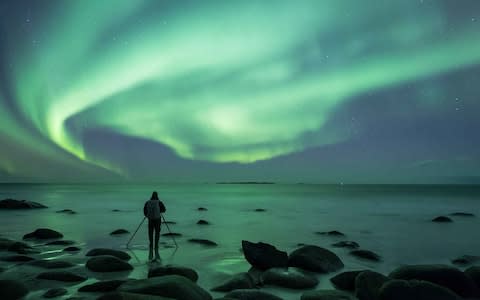Eyes on the skies tonight as giant solar flare brings a good chance of spotting the Northern Lights in the UK

There is a reasonable assumption that, when it comes to the aurora borealis, you need to go a fair way north to see them.
This, after all, is the celestial phenomenon which occurs when charged solar particles strike the magnetic fields above the earth's poles. So if you want to see the sky dance through various hues of green, purple, blue and pink, it is probably fair to think you have to visit the polar regions - rather than stay in the UK.
But not, perhaps, tonight and tomorrow (Wednesday March 14 and Thursday March 15) - thanks to the solar flare which burst into life earlier this week, significantly boosting the chances of the Northern Lights being seen in Britain in the next 48 hours.
Solar flares are sudden flashes of notably increased brightness in the sun.
They tend to be the spark for a "Coronal Mass Ejection" (CME) - an explosive release of the electromagnetic matter which is crucial in triggering displays of the aurora borealis (and its southern counterpart, the aurora australis).

An accompanying solar storm is expected to descend on Britain in the next two days, ahead of the vernal equinox on March 20. This signifier of the European and North American spring, when the sun crosses the equator from the Southern Hemisphere to the North, is often also a backdrop to considerably increased levels of solar activity.
This coming phenomenon may register as highly as the mid-point on the K-Index - the scale used to gauge the strength of disturbances in Earth's magnetic field.

The index runs from zero to up to nine, with a reading of five indicating a geomagnetic storm.
According to the Space Weather Prediction Centre (swpc.noaa.gov) - a laboratory run by the US National Weather Service, based in Boulder, Colorado - such a measurement could be on the cards tonight and tomorrow night, making sightings of the Northern Lights in the UK more possible.
“The equinox is often associated with higher levels of solar activity, so we may see KP-5 on the K-Index tonight," explains Alistair McLean of tour operator The Aurora Zone (theaurorazone.com), which specialises in tours that go in search of the Northern Lights. "As a basic rule, the larger the number, the further south the lights can be seen. This means that the Northern Lights may be visible in northern Scotland."
Jonny Cooper of Off the Map Travel (offthemap.travel) is equally enthusastic about the possibility of imminent aurora sightings in Britain. “You never know what will happen with the Northern Lights," he says, "but with news [of the solar flare] like this, I would recommend anyone in Scotland and northern England to keep an eye on the sky.”
"To increase your chances here in the UK, head north and find a spot with as little light pollution as possible. It’s worth the chase."
Aurora sightings over Britain are not uncommon - although seeing the Northern Lights on home shores often requires specialist photographic equipment rather than the naked eye. October 2015, for example, witnessed a celestial display which was caught on camera in the likes of Keswick in the Lake District, Brecon in South Wales and above both Lough Neagh in Northern Ireland and the Peak District in Derbyshire.
Generally, however, you need to venture to the upper reaches of Scotland for a better chance of an clear glimpse - with the Orkney and Shetland Islands usually proving to be the most likely locations.
Shetland is such a fertile context for the Northern Lights that one aurora-angled organisation has opened a research post there.
AuroraWatch UK (aurorawatch.lancs.ac.uk), which is based at Lancaster University, installed a detector in the archipelago last summer to give advance warning of potential sightings. Previously, the body's northernmost such facility has been in Aberdeen.

In September, it announced that a magnetometer had been added to the grounds of the Sumburgh Head lighthouse, at the southern tip the biggest Shetland island, Mainland.
"[The magnetometer] will allow us to detect even the weakest of auroral activity, and may allow us to detect auroral activity earlier than we do now," the organisation said in a statement.
"It will also mean that we have a good coverage of magnetometers along the length of the UK. This coverage will allow us to scientifically study the variations in the earth’s magnetic field, caused by the aurora, on a (relatively) small spatial scale."
AuroraWatch UK is offering updates on the latest solar storm at twitter.com/AWUK_Shetland.

